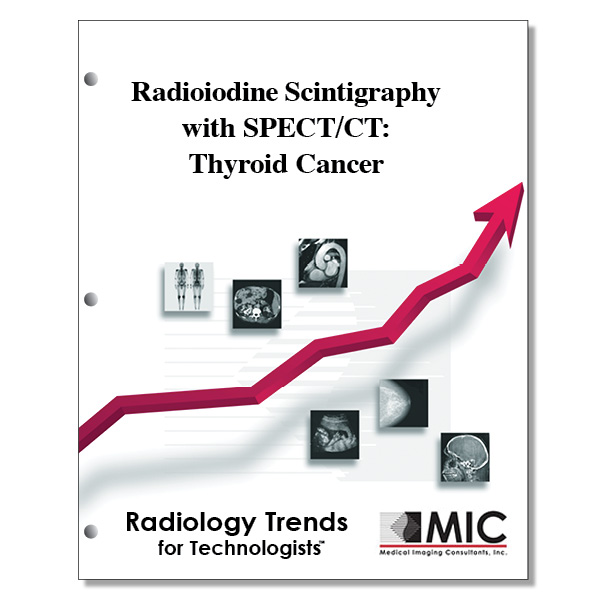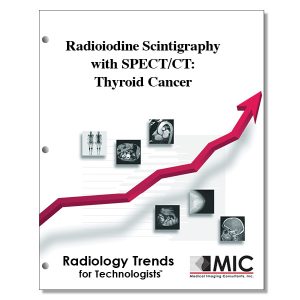

Radioiodine Scintigraphy with SPECT/CT: Thyroid Cancer
A presentation of SPECT/CT as an important tool for thyroid cancer staging and risk stratification.
Course ID: Q00342 Category: Radiology Trends for Technologists Modalities: CT, Nuclear Medicine, Radiation Therapy3.0 |
Satisfaction Guarantee |
$34.00
- Targeted CE
- Outline
- Objectives
Targeted CE
Targeted CE per ARRT’s Discipline, Category, and Subcategory classification:
[Note: Discipline-specific Targeted CE credits may be less than the total Category A credits approved for this course.]
Magnetic Resonance Imaging: 0.75
Patient Care: 0.75
Patient Interactions and Management: 0.75
Nuclear Medicine Technology: 3.00
Procedures: 3.00
Endocrine and Oncology Procedures: 3.00
Radiography: 0.75
Patient Care: 0.75
Patient Interactions and Management: 0.75
Registered Radiologist Assistant: 3.00
Procedures: 3.00
Musculoskeletal and Endocrine Sections: 3.00
Sonography: 0.75
Patient Care: 0.75
Patient Interactions and Management: 0.75
Radiation Therapy: 3.00
Patient Care: 1.50
Patient and Medical Record Management: 1.50
Procedures: 1.50
Treatment Sites and Tumors: 1.50
Outline
Outline
- Introduction
- Advantages, Disadvantages, and Limitations of SPECT/CT
- Utility of Post-therapy Radioiodine SPECT/CT
- Utility of SPECT/CT for Problem Solving (Evaluation of Unusual Radioactivity Distributions
- Utility of Diagnostic Preablation Radioiodine SPECT/CT
- Utility of Radioiodine SPECT/CT for Lesional Dosimetry
- When to use SPECT/CT for Best Impact in Thyroid Cancer Management
- Conclusion
Objectives
Objectives
Upon completion of this course, students will:
- be familiar with the most characterized thyroid cancer based on histology
- know the histological subtypes of papillary thyroid cancer
- understand the most commonly used staging system for thyroid cancer
- be familiar with how thyroid cancer patients are staged by TNM classifications
- understand how thyroid cancer patients are scored by TNM classifications
- be able to use the provided table to understand how patients are staged for thyroid cancer
- be familiar with ATA guidelines for recommendation of 131I ablation therapy
- be familiar with ATA guidelines for those not recommended for 131I ablation therapy
- be familiar with the overall trend for thyroid cancer in the United States and Western Europe
- be familiar with the percentage of deaths from thyroid malignancy
- understand the advantages and disadvantages of SPECT/CT over planar scintigraphy
- understand the limitations of detecting micrometastatic lesions with SPECT/CT
- be familiar with the percentage of differentiated thyroid cancer that remains undetected on SPECT/CT
- be familiar with the histopathological and biochemical data necessary for accurate interpretation of findings on planar and SPECT/CT scintigraphy
- understand the effects of spatial degradation on a SPECT/CT scans
- be familiar with SPECT/CT’s ability to reduce equivocal foci on scans
- understand that 131I SPECT/CT performed at first ablation can predict the occurrence or persistence of iodine-avid cervical nodal metastases
- understand that CT data from SPECT/CT can reduce the need for additional imaging studies and increase in the detection of non-iodine-avid metastases
- know that postablation scintigraphy has prognostic value for predicting outcomes of thyroid cancer patients
- understand that planar WBS and SPECT/CT radioiodine scintigraphy can increase sensitivity and specificity in predicting recurrent or persistent disease in thyroid cancer patients
- identify what the range of acceptable diagnostic dosing is for SPECT/CT radioiodine scintigraphy
- be familiar with the areas of incremental value of SPECT/CT as compared with WBS
- be familiar with the incremental value SPECT/CT radioiodine scintigraphy has over planar scintigraphy imaging
- be familiar with the SPECT/CT advantages for rapid exclusion of physiologic activity or contamination during interpretation
- identify which diagnostic tests changed the prescribed therapeutic dose for thyroid cancer patients
- be able to define remnant radioiodine therapy
- be able to define adjuvant radioiodine therapy
- be familiar with the photopeak energy for 131I
- identify the appropriate collimator for imaging with 131I
- understand the value of the CT component of SPECT/CT for lesion-specific dosimetry
- be familiar with the advantages of diagnostic 131I scintigraphy in detecting metastases in normal-sized lymph nodes on a postoperative neck
- understand the earlier detection of bone metastases due to the use of SPECT/CT radioiodine scintigraphy
- identify which nuclear medicine imaging tests may not portray the full extent of skeletal metastatic disease
- know how preablation radioiodine scans alter the management plans of thyroid cancer patients
- understand when the dosimetry calculations based on percentage whole-body retention should be conducted
- be familiar with the improvement of tumor characterization by using SPECT/CT radioiodine scintigraphy
- identify the therapeutic properties of 131I
- understand the pregnancy precautions for patients undergoing 131I therapy
- be familiar with the proper dose range for postoperative ablation 131I therapy for thyroid bed remnants
- be familiar with who is qualified to administer 131I therapeutic doses
